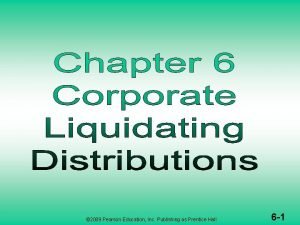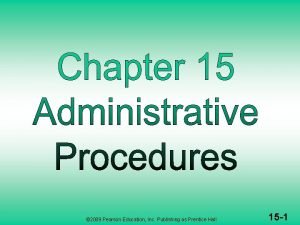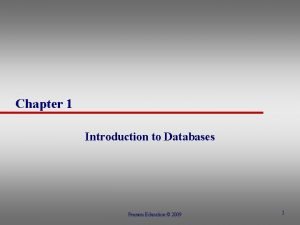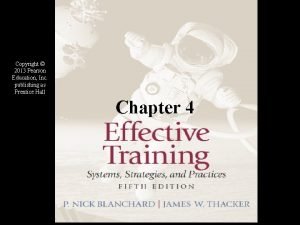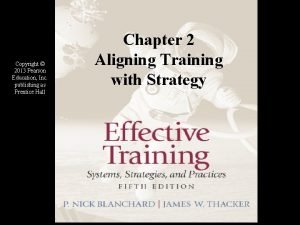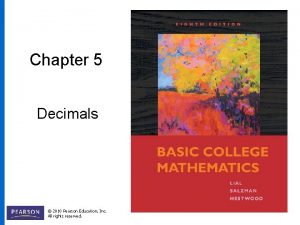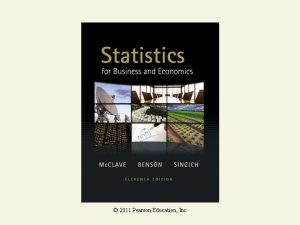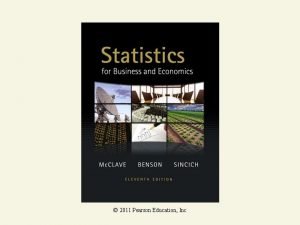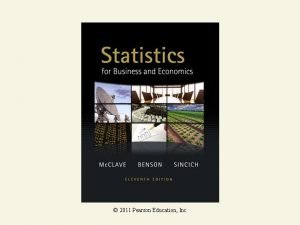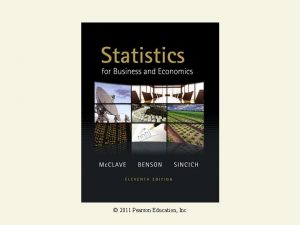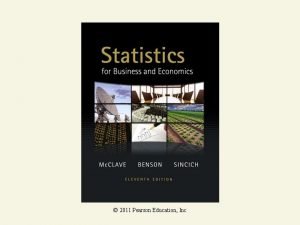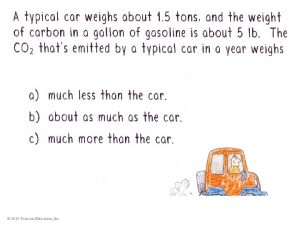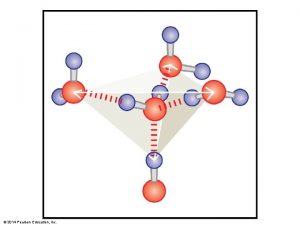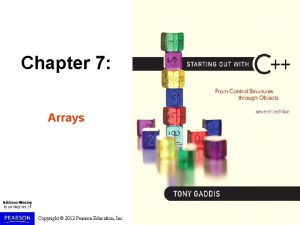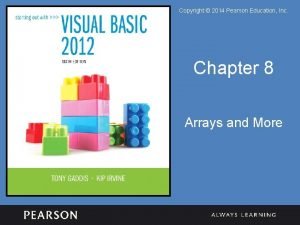Chapter 7 Arrays Copyright 2009 Pearson Education Inc



![Array - Memory Layout • The definition: int tests[5]; allocates the following memory: first Array - Memory Layout • The definition: int tests[5]; allocates the following memory: first](https://slidetodoc.com/presentation_image_h/237a74186f275c82ab0ca39300f1cb46/image-4.jpg)
![Array Terminology In the definition int tests[5]; • int is the data type of Array Terminology In the definition int tests[5]; • int is the data type of](https://slidetodoc.com/presentation_image_h/237a74186f275c82ab0ca39300f1cb46/image-5.jpg)





![Accessing Array Elements • Array elements can be used as regular variables: tests[0] = Accessing Array Elements • Array elements can be used as regular variables: tests[0] =](https://slidetodoc.com/presentation_image_h/237a74186f275c82ab0ca39300f1cb46/image-11.jpg)
























![Finding the Highest Value in an Array int count; int highest; highest = numbers[0]; Finding the Highest Value in an Array int count; int highest; highest = numbers[0];](https://slidetodoc.com/presentation_image_h/237a74186f275c82ab0ca39300f1cb46/image-36.jpg)
![Finding the Lowest Value in an Array int count; int lowest; lowest = numbers[0]; Finding the Lowest Value in an Array int count; int lowest; lowest = numbers[0];](https://slidetodoc.com/presentation_image_h/237a74186f275c82ab0ca39300f1cb46/image-37.jpg)




![Parallel Array Example const int SIZE = 5; // Array size int id[SIZE]; // Parallel Array Example const int SIZE = 5; // Array size int id[SIZE]; //](https://slidetodoc.com/presentation_image_h/237a74186f275c82ab0ca39300f1cb46/image-42.jpg)











![Two-Dimensional Array Representation const int ROWS = 4, COLS = 3; int exams[ROWS][COLS]; columns Two-Dimensional Array Representation const int ROWS = 4, COLS = 3; int exams[ROWS][COLS]; columns](https://slidetodoc.com/presentation_image_h/237a74186f275c82ab0ca39300f1cb46/image-54.jpg)

























- Slides: 79

Chapter 7: Arrays Copyright © 2009 Pearson Education, Inc. Copyright 2009 Addison-Wesley Pearson Education, Publishing as©Pearson Inc. Publishing as Pearson Addison-Wesley

7. 1 • Arrays Hold Multiple Values Copyright © 2009 Pearson Education, Inc. Publishing as Pearson Addison-Wesley

Arrays Hold Multiple Values • Array: variable that can store multiple values of the same type • Values are stored in adjacent memory locations • Declared using [] operator: int tests[5]; Copyright © 2009 Pearson Education, Inc. Publishing as Pearson Addison-Wesley 3
![Array Memory Layout The definition int tests5 allocates the following memory first Array - Memory Layout • The definition: int tests[5]; allocates the following memory: first](https://slidetodoc.com/presentation_image_h/237a74186f275c82ab0ca39300f1cb46/image-4.jpg)
Array - Memory Layout • The definition: int tests[5]; allocates the following memory: first element second element third element fourth element Copyright © 2009 Pearson Education, Inc. Publishing as Pearson Addison-Wesley fifth element 4
![Array Terminology In the definition int tests5 int is the data type of Array Terminology In the definition int tests[5]; • int is the data type of](https://slidetodoc.com/presentation_image_h/237a74186f275c82ab0ca39300f1cb46/image-5.jpg)
Array Terminology In the definition int tests[5]; • int is the data type of the array elements • tests is the name of the array • 5, in [5], is the size declarator. It shows the number of elements in the array. • The size of an array is (number of elements) * (size of each element) Copyright © 2009 Pearson Education, Inc. Publishing as Pearson Addison-Wesley 5

Array Terminology • The size of an array is: – the total number of bytes allocated for it – (number of elements) * (number of bytes for each element) • Examples: int tests[5] is an array of 20 bytes, assuming 4 bytes for an int long double measures[10]is an array of 80 bytes, assuming 8 bytes for a long double Copyright © 2009 Pearson Education, Inc. Publishing as Pearson Addison-Wesley 6

Size Declarators • Named constants are commonly used as size declarators. const int SIZE = 5; int tests[SIZE]; • This eases program maintenance when the size of the array needs to be changed. Copyright © 2009 Pearson Education, Inc. Publishing as Pearson Addison-Wesley 7

7. 2 • Accessing Array Elements Copyright © 2009 Pearson Education, Inc. Publishing as Pearson Addison-Wesley

Accessing Array Elements • Each element in an array is assigned a unique subscript. • Subscripts start at 0 subscripts: 0 1 2 3 Copyright © 2009 Pearson Education, Inc. Publishing as Pearson Addison-Wesley 4 9

Accessing Array Elements • The last element’s subscript is n-1 where n is the number of elements in the array. subscripts: 0 1 2 3 Copyright © 2009 Pearson Education, Inc. Publishing as Pearson Addison-Wesley 4 10
![Accessing Array Elements Array elements can be used as regular variables tests0 Accessing Array Elements • Array elements can be used as regular variables: tests[0] =](https://slidetodoc.com/presentation_image_h/237a74186f275c82ab0ca39300f1cb46/image-11.jpg)
Accessing Array Elements • Array elements can be used as regular variables: tests[0] = 79; cout << tests[0]; cin >> tests[1]; tests[4] = tests[0] + tests[1]; • Arrays must be accessed via individual elements: cout << tests; // not legal Copyright © 2009 Pearson Education, Inc. Publishing as Pearson Addison-Wesley 11

(Program Continues) Copyright © 2009 Pearson Education, Inc. Publishing as Pearson Addison-Wesley 12

Here are the contents of the hours array, with the values entered by the user in the example output: Copyright © 2009 Pearson Education, Inc. Publishing as Pearson Addison-Wesley 13

Accessing Array Contents • Can access element with a constant or literal subscript: cout << tests[3] << endl; • Can use integer expression as subscript: int i = 5; cout << tests[i] << endl; Copyright © 2009 Pearson Education, Inc. Publishing as Pearson Addison-Wesley 14

Using a Loop to Step Through an Array • Example – The following code defines an array, numbers, and assigns 99 to each element: const int ARRAY_SIZE = 5; int numbers[ARRAY_SIZE]; for (int count = 0; count < ARRAY_SIZE; count++) numbers[count] = 99; Copyright © 2009 Pearson Education, Inc. Publishing as Pearson Addison-Wesley 15

A Closer Look At the Loop Copyright © 2009 Pearson Education, Inc. Publishing as Pearson Addison-Wesley 16

Default Initialization • Global array all elements initialized to 0 by default • Local array all elements uninitialized by default Copyright © 2009 Pearson Education, Inc. Publishing as Pearson Addison-Wesley 17

7. 3 • No Bounds Checking in C++ Copyright © 2009 Pearson Education, Inc. Publishing as Pearson Addison-Wesley

No Bounds Checking in C++ • When you use a value as an array subscript, C++ does not check it to make sure it is a valid subscript. • In other words, you can use subscripts that are beyond the bounds of the array. Copyright © 2009 Pearson Education, Inc. Publishing as Pearson Addison-Wesley 19

Code From Program 7 -5 • The following code defines a three-element array, and then writes five values to it! Copyright © 2009 Pearson Education, Inc. Publishing as Pearson Addison-Wesley 20

What the Code Does Copyright © 2009 Pearson Education, Inc. Publishing as Pearson Addison-Wesley 21

No Bounds Checking in C++ • Be careful not to use invalid subscripts. • Doing so can corrupt other memory locations, crash program, or lock up computer, and cause elusive bugs. Copyright © 2009 Pearson Education, Inc. Publishing as Pearson Addison-Wesley 22

Off-By-One Errors • An off-by-one error happens when you use array subscripts that are off by one. • This can happen when you start subscripts at 1 rather than 0: // This code has an off-by-one error. const int SIZE = 100; int numbers[SIZE]; for (int count = 1; count <= SIZE; count++) numbers[count] = 0; Copyright © 2009 Pearson Education, Inc. Publishing as Pearson Addison-Wesley 23

7. 4 • Array Initialization Copyright © 2009 Pearson Education, Inc. Publishing as Pearson Addison-Wesley

Array Initialization • Arrays can be initialized with an initialization list: const int SIZE = 5; int tests[SIZE] = {79, 82, 91, 77, 84}; • The values are stored in the array in the order in which they appear in the list. • The initialization list cannot exceed the array size. Copyright © 2009 Pearson Education, Inc. Publishing as Pearson Addison-Wesley 25

Code From Program 7 -6 Copyright © 2009 Pearson Education, Inc. Publishing as Pearson Addison-Wesley 26

Partial Array Initialization • If array is initialized with fewer initial values than the size declarator, the remaining elements will be set to 0: Copyright © 2009 Pearson Education, Inc. Publishing as Pearson Addison-Wesley 27

Implicit Array Sizing • Can determine array size by the size of the initialization list: int quizzes[]={12, 17, 15, 11}; 12 17 15 11 • Must use either array size declarator or initialization list at array definition Copyright © 2009 Pearson Education, Inc. Publishing as Pearson Addison-Wesley 28

Initializing With a String • Character array can be initialized by enclosing string in " ": const int SIZE = 6; char f. Name[SIZE] = "Henry"; • Must leave room for � at end of array • If initializing character-by-character, must add in � explicitly: char f. Name[SIZE] = { 'H', 'e', 'n', 'r', 'y', '�'}; Copyright © 2009 Pearson Education, Inc. Publishing as Pearson Addison-Wesley 29

7. 5 • Processing Array Contents Copyright © 2009 Pearson Education, Inc. Publishing as Pearson Addison-Wesley

Processing Array Contents • Array elements can be treated as ordinary variables of the same type as the array • When using ++, -- operators, don’t confuse the element with the subscript: tests[i]++; // add 1 to tests[i] tests[i++]; // increment i, no // effect on tests Copyright © 2009 Pearson Education, Inc. Publishing as Pearson Addison-Wesley 31

Array Assignment To copy one array to another, • Don’t try to assign one array to the other: new. Tests = tests; // Won't work • Instead, assign element-by-element: for (i = 0; i < ARRAY_SIZE; i++) new. Tests[i] = tests[i]; Copyright © 2009 Pearson Education, Inc. Publishing as Pearson Addison-Wesley 32

Printing the Contents of an Array • You can display the contents of a character array by sending its name to cout: char f. Name[] = "Henry"; cout << f. Name << endl; But, this ONLY works with character arrays! Copyright © 2009 Pearson Education, Inc. Publishing as Pearson Addison-Wesley 33

Printing the Contents of an Array • For other types of arrays, you must print element-by-element: for (i = 0; i < ARRAY_SIZE; i++) cout << tests[i] << endl; Copyright © 2009 Pearson Education, Inc. Publishing as Pearson Addison-Wesley 34

Summing and Averaging Array Elements • Use a simple loop to add together array elements: int tnum; double average, sum = 0; for(tnum = 0; tnum < SIZE; tnum++) sum += tests[tnum]; • Once summed, can compute average: average = sum / SIZE; Copyright © 2009 Pearson Education, Inc. Publishing as Pearson Addison-Wesley 35
![Finding the Highest Value in an Array int count int highest highest numbers0 Finding the Highest Value in an Array int count; int highest; highest = numbers[0];](https://slidetodoc.com/presentation_image_h/237a74186f275c82ab0ca39300f1cb46/image-36.jpg)
Finding the Highest Value in an Array int count; int highest; highest = numbers[0]; for (count = 1; count < SIZE; count++) { if (numbers[count] > highest) highest = numbers[count]; } When this code is finished, the highest variable will contain the highest value in the numbers array. Copyright © 2009 Pearson Education, Inc. Publishing as Pearson Addison-Wesley 36
![Finding the Lowest Value in an Array int count int lowest lowest numbers0 Finding the Lowest Value in an Array int count; int lowest; lowest = numbers[0];](https://slidetodoc.com/presentation_image_h/237a74186f275c82ab0ca39300f1cb46/image-37.jpg)
Finding the Lowest Value in an Array int count; int lowest; lowest = numbers[0]; for (count = 1; count < SIZE; count++) { if (numbers[count] < lowest) lowest = numbers[count]; } When this code is finished, the lowest variable will contain the lowest value in the numbers array. Copyright © 2009 Pearson Education, Inc. Publishing as Pearson Addison-Wesley 37

Partially-Filled Arrays • If it is unknown how much data an array will be holding: – Make the array large enough to hold the largest expected number of elements. – Use a counter variable to keep track of the number of items stored in the array. Copyright © 2009 Pearson Education, Inc. Publishing as Pearson Addison-Wesley 38

Comparing Arrays • To compare two arrays, you must compare element-by-element: const int SIZE = 5; int first. Array[SIZE] = { 5, 10, 15, 20, 25 }; int second. Array[SIZE] = { 5, 10, 15, 20, 25 }; bool arrays. Equal = true; // Flag variable int count = 0; // Loop counter variable // Compare the two arrays. while (arrays. Equal && count < SIZE) { if (first. Array[count] != second. Array[count]) arrays. Equal = false; count++; } if (arrays. Equal) cout << "The arrays are equal. n"; else cout << "The arrays are not equal. n"; Copyright © 2009 Pearson Education, Inc. Publishing as Pearson Addison-Wesley 39

7. 6 • Using Parallel Arrays Copyright © 2009 Pearson Education, Inc. Publishing as Pearson Addison-Wesley

Using Parallel Arrays • Parallel arrays: two or more arrays that contain related data • A subscript is used to relate arrays: elements at same subscript are related • Arrays may be of different types Copyright © 2009 Pearson Education, Inc. Publishing as Pearson Addison-Wesley 41
![Parallel Array Example const int SIZE 5 Array size int idSIZE Parallel Array Example const int SIZE = 5; // Array size int id[SIZE]; //](https://slidetodoc.com/presentation_image_h/237a74186f275c82ab0ca39300f1cb46/image-42.jpg)
Parallel Array Example const int SIZE = 5; // Array size int id[SIZE]; // student ID double average[SIZE]; // course average char grade[SIZE]; // course grade. . . for(int i = 0; i < SIZE; i++) { cout << "Student ID: " << id[i] << " average: " << average[i] << " grade: " << grade[i] << endl; } Copyright © 2009 Pearson Education, Inc. Publishing as Pearson Addison-Wesley 42

(Program Continues) Copyright © 2009 Pearson Education, Inc. Publishing as Pearson Addison-Wesley 43

Program 7 -12 (Continued) Copyright © 2009 Pearson Education, Inc. Publishing as Pearson Addison-Wesley 44

The hours and pay. Rate arrays are related through their subscripts: Copyright © 2009 Pearson Education, Inc. Publishing as Pearson Addison-Wesley 45

7. 7 • Arrays as Function Arguments Copyright © 2009 Pearson Education, Inc. Publishing as Pearson Addison-Wesley

Arrays as Function Arguments • To pass an array to a function, just use the array name: show. Scores(tests); • To define a function that takes an array parameter, use empty [] for array argument: void show. Scores(int []); // function prototype void show. Scores(int tests[]) // function header Copyright © 2009 Pearson Education, Inc. Publishing as Pearson Addison-Wesley 47

Arrays as Function Arguments • When passing an array to a function, it is common to pass array size so that function knows how many elements to process: show. Scores(tests, ARRAY_SIZE); • Array size must also be reflected in prototype, header: void show. Scores(int [], int); // function prototype void show. Scores(int tests[], int size) // function header Copyright © 2009 Pearson Education, Inc. Publishing as Pearson Addison-Wesley 48

(Program Continues) Copyright © 2009 Pearson Education, Inc. Publishing as Pearson Addison-Wesley 49

Program 7 -14 (Continued) Copyright © 2009 Pearson Education, Inc. Publishing as Pearson Addison-Wesley 50

Modifying Arrays in Functions • Array names in functions are like reference variables – changes made to array in a function are reflected in actual array in calling function • Need to exercise caution that array is not inadvertently changed by a function Copyright © 2009 Pearson Education, Inc. Publishing as Pearson Addison-Wesley 51

7. 8 • Two-Dimensional Arrays Copyright © 2009 Pearson Education, Inc. Publishing as Pearson Addison-Wesley

Two-Dimensional Arrays • Can define one array for multiple sets of data • Like a table in a spreadsheet • Use two size declarators in definition: const int ROWS = 4, COLS = 3; int exams[ROWS][COLS]; • First declarator is number of rows; second is number of columns Copyright © 2009 Pearson Education, Inc. Publishing as Pearson Addison-Wesley 53
![TwoDimensional Array Representation const int ROWS 4 COLS 3 int examsROWSCOLS columns Two-Dimensional Array Representation const int ROWS = 4, COLS = 3; int exams[ROWS][COLS]; columns](https://slidetodoc.com/presentation_image_h/237a74186f275c82ab0ca39300f1cb46/image-54.jpg)
Two-Dimensional Array Representation const int ROWS = 4, COLS = 3; int exams[ROWS][COLS]; columns r o w s exams[0][0] exams[0][1] exams[0][2] exams[1][0] exams[1][1] exams[1][2] exams[2][0] exams[2][1] exams[2][2] exams[3][0] exams[3][1] exams[3][2] • Use two subscripts to access element: exams[2][2] = 86; Copyright © 2009 Pearson Education, Inc. Publishing as Pearson Addison-Wesley 54

Copyright © 2009 Pearson Education, Inc. Publishing as Pearson Addison-Wesley 55

Copyright © 2009 Pearson Education, Inc. Publishing as Pearson Addison-Wesley 56

Copyright © 2009 Pearson Education, Inc. Publishing as Pearson Addison-Wesley 57

2 D Array Initialization • Two-dimensional arrays are initialized row-by-row: const int ROWS = 2, COLS = 2; int exams[ROWS][COLS] = { {84, 78}, {92, 97} }; 84 78 92 97 • Can omit inner { }, some initial values in a row – array elements without initial values will be set to 0 or NULL Copyright © 2009 Pearson Education, Inc. Publishing as Pearson Addison-Wesley 58

Two-Dimensional Array as Parameter, Argument • Use array name as argument in function call: get. Exams(exams, 2); • Use empty [] for row, size declarator for column in prototype, header: const int COLS = 2; // Prototype void get. Exams(int [][COLS], int); // Header void get. Exams(int exams[][COLS], int rows) Copyright © 2009 Pearson Education, Inc. Publishing as Pearson Addison-Wesley 59

Example – The show. Array Function from Program 7 -19 Copyright © 2009 Pearson Education, Inc. Publishing as Pearson Addison-Wesley 60

How show. Array is Called Copyright © 2009 Pearson Education, Inc. Publishing as Pearson Addison-Wesley 61

Summing All the Elements in a Two-Dimensional Array • Given the following definitions: const int NUM_ROWS = 5; // Number of rows const int NUM_COLS = 5; // Number of columns int total = 0; // Accumulator int numbers[NUM_ROWS][NUM_COLS] = {{2, 7, 9, 6, 4}, {6, 1, 8, 9, 4}, {4, 3, 7, 2, 9}, {9, 9, 0, 3, 1}, {6, 2, 7, 4, 1}}; Copyright © 2009 Pearson Education, Inc. Publishing as Pearson Addison-Wesley 62

Summing All the Elements in a Two-Dimensional Array // Sum the array elements. for (int row = 0; row < NUM_ROWS; row++) { for (int col = 0; col < NUM_COLS; col++) total += numbers[row][col]; } // Display the sum. cout << "The total is " << total << endl; Copyright © 2009 Pearson Education, Inc. Publishing as Pearson Addison-Wesley 63

Summing the Rows of a Two-Dimensional Array • Given the following definitions: const int NUM_STUDENTS = 3; const int NUM_SCORES = 5; double total; // Accumulator double average; // To hold average scores double scores[NUM_STUDENTS][NUM_SCORES] = {{88, 97, 79, 86, 94}, {86, 91, 78, 79, 84}, {82, 73, 77, 82, 89}}; Copyright © 2009 Pearson Education, Inc. Publishing as Pearson Addison-Wesley 64

Summing the Rows of a Two-Dimensional Array // Get each student's average score. for (int row = 0; row < NUM_STUDENTS; row++) { // Set the accumulator. total = 0; // Sum a row. for (int col = 0; col < NUM_SCORES; col++) total += scores[row][col]; // Get the average = total / NUM_SCORES; // Display the average. cout << "Score average for student " << (row + 1) << " is " << average <<endl; } Copyright © 2009 Pearson Education, Inc. Publishing as Pearson Addison-Wesley 65

Summing the Columns of a Two-Dimensional Array • Given the following definitions: const int NUM_STUDENTS = 3; const int NUM_SCORES = 5; double total; // Accumulator double average; // To hold average scores double scores[NUM_STUDENTS][NUM_SCORES] = {{88, 97, 79, 86, 94}, {86, 91, 78, 79, 84}, {82, 73, 77, 82, 89}}; Copyright © 2009 Pearson Education, Inc. Publishing as Pearson Addison-Wesley 66

Summing the Columns of a Two. Dimensional Array // Get the class average for each score. for (int col = 0; col < NUM_SCORES; col++) { // Reset the accumulator. total = 0; // Sum a column for (int row = 0; row < NUM_STUDENTS; row++) total += scores[row][col]; // Get the average = total / NUM_STUDENTS; // Display the class average. cout << "Class average for test " << (col + 1) << " is " << average << endl; } Copyright © 2009 Pearson Education, Inc. Publishing as Pearson Addison-Wesley 67

7. 9 • Array of Strings Copyright © 2009 Pearson Education, Inc. Publishing as Pearson Addison-Wesley

Array of Strings • Use a two-dimensional array of characters as an array of strings: const int NAMES = 3, SIZE = 10; char students[NAMES][SIZE] = { "Ann", "Bill", "Cindy" }; • Each row contains one string • Can use row subscript to reference the string in a particular row: cout << students[i]; Copyright © 2009 Pearson Education, Inc. Publishing as Pearson Addison-Wesley 69

Copyright © 2009 Pearson Education, Inc. Publishing as Pearson Addison-Wesley 70

Copyright © 2009 Pearson Education, Inc. Publishing as Pearson Addison-Wesley 71

7. 10 • Arrays with Three or More Dimensions Copyright © 2009 Pearson Education, Inc. Publishing as Pearson Addison-Wesley

Arrays with Three or More Dimensions • Can define arrays with any number of dimensions: short rect. Solid[2][3][5]; double time. Grid[3][4]; • When used as parameter, specify all but 1 st dimension in prototype, heading: void get. Rect. Solid(short [][3][5]); Copyright © 2009 Pearson Education, Inc. Publishing as Pearson Addison-Wesley 73

7. 12 • Introduction to the STL vector Copyright © 2009 Pearson Education, Inc. Publishing as Pearson Addison-Wesley

Introduction to the STL vector • A data type defined in the Standard Template Library (covered more in Chapter 16) • Can hold values of any type: vector<int> scores; • Automatically adds space as more is needed – no need to determine size at definition • Can use [] to access elements Copyright © 2009 Pearson Education, Inc. Publishing as Pearson Addison-Wesley 75

Declaring Vectors • You must #include<vector> • Declare a vector to hold int element: vector<int> scores; • Declare a vector with initial size 30: vector<int> scores(30); • Declare a vector and initialize all elements to 0: vector<int> scores(30, 0); • Declare a vector initialized to size and contents of another vector: vector<int> finals(scores); Copyright © 2009 Pearson Education, Inc. Publishing as Pearson Addison-Wesley 76

Adding Elements to a Vector • Use push_back member function to add element to a full array or to an array that had no defined size: scores. push_back(75); • Use size member function to determine size of a vector: howbig = scores. size(); Copyright © 2009 Pearson Education, Inc. Publishing as Pearson Addison-Wesley 77

Removing Vector Elements • Use pop_back member function to remove last element from vector: scores. pop_back(); • To remove all contents of vector, use clear member function: scores. clear(); • To determine if vector is empty, use empty member function: while (!scores. empty()). . . Copyright © 2009 Pearson Education, Inc. Publishing as Pearson Addison-Wesley 78

Other Useful Member Functions Member Function Description at(elt) Returns the value of the element at cout << vec 1. at(i); position elt in the vector capacity() maxelts = Returns the maximum number of elements a vector can store without vec 1. capacity(); allocating more memory Reverse the order of the elements vec 1. reverse(); in a vector reverse() Example resize (elts, val) Add elements to a vector, optionally initializes them vec 1. resize(5, 0); swap(vec 2) Exchange the contents of two vectors vec 1. swap(vec 2); Copyright © 2009 Pearson Education, Inc. Publishing as Pearson Addison-Wesley 79
 Copyright 2009 pearson education inc
Copyright 2009 pearson education inc Copyright 2009 pearson education inc
Copyright 2009 pearson education inc Copyright 2009 pearson education inc
Copyright 2009 pearson education inc 2009 pearson education inc
2009 pearson education inc 2009 pearson education inc
2009 pearson education inc 2009 pearson education inc
2009 pearson education inc 2009 pearson education inc
2009 pearson education inc 2009 pearson education inc
2009 pearson education inc 2009 pearson education inc
2009 pearson education inc 2009 pearson education inc
2009 pearson education inc 2009 pearson education inc
2009 pearson education inc 2017 pearson education ltd
2017 pearson education ltd 2017 pearson education inc
2017 pearson education inc Copyright 2010 pearson education inc
Copyright 2010 pearson education inc 2018 pearson education inc
2018 pearson education inc 2014 pearson education inc
2014 pearson education inc Copyright 2010 pearson education inc
Copyright 2010 pearson education inc Copyright 2010 pearson education inc
Copyright 2010 pearson education inc Copyright by pearson education inc. answers
Copyright by pearson education inc. answers Copyright 2003 pearson education inc
Copyright 2003 pearson education inc 2015 pearson education inc
2015 pearson education inc Copyright 2010 pearson education inc
Copyright 2010 pearson education inc Copyright 2010 pearson education inc
Copyright 2010 pearson education inc Copyright 2010 pearson education inc
Copyright 2010 pearson education inc Copyright 2010 pearson education inc
Copyright 2010 pearson education inc Copyright 2010 pearson education inc
Copyright 2010 pearson education inc Composition copyright example
Composition copyright example Copyright 2010 pearson education inc
Copyright 2010 pearson education inc Copyright pearson education inc
Copyright pearson education inc Pearson education 2011
Pearson education 2011 Pearson education inc publishing as pearson prentice hall
Pearson education inc publishing as pearson prentice hall Pearson education inc publishing as pearson prentice hall
Pearson education inc publishing as pearson prentice hall Pearson 2012
Pearson 2012 Pearson education inc publishing as pearson prentice hall
Pearson education inc publishing as pearson prentice hall Copyright 2005 pearson prentice hall inc
Copyright 2005 pearson prentice hall inc Pearson education 2009
Pearson education 2009 2017 pearson education inc
2017 pearson education inc 2017 pearson education inc
2017 pearson education inc 2017 pearson education inc
2017 pearson education inc 2017 pearson education inc
2017 pearson education inc 2016 pearson education inc
2016 pearson education inc 2015 pearson education inc
2015 pearson education inc 2014 pearson education inc
2014 pearson education inc 2013 pearson education inc
2013 pearson education inc 2013 pearson education inc
2013 pearson education inc 2013 pearson education inc. answers
2013 pearson education inc. answers 2013 pearson education inc
2013 pearson education inc 2012 pearson education inc
2012 pearson education inc 2012 pearson education inc
2012 pearson education inc Pearson education 2012
Pearson education 2012 2010 pearson education inc
2010 pearson education inc 2016 pearson education inc
2016 pearson education inc 2010 pearson education inc answers
2010 pearson education inc answers 2010 pearson education inc
2010 pearson education inc 2014 pearson education inc
2014 pearson education inc 2014 pearson education inc
2014 pearson education inc 2014 pearson education inc
2014 pearson education inc 2014 pearson education inc
2014 pearson education inc 2014 pearson education inc
2014 pearson education inc 2014 pearson education inc
2014 pearson education inc 2014 pearson education inc
2014 pearson education inc 2012 pearson education inc
2012 pearson education inc 2011 pearson education inc
2011 pearson education inc 2011 pearson education inc
2011 pearson education inc 2011 pearson education inc
2011 pearson education inc Friedman rank test
Friedman rank test 2011 pearson education inc
2011 pearson education inc 2011 pearson education inc
2011 pearson education inc 2010 pearson education inc answers
2010 pearson education inc answers 2016 pearson education inc
2016 pearson education inc 2017 pearson education inc
2017 pearson education inc 2016 pearson education inc
2016 pearson education inc 2016 pearson education inc
2016 pearson education inc 2016 pearson education inc
2016 pearson education inc 2014 pearson education inc
2014 pearson education inc 2013 pearson education inc
2013 pearson education inc 2013 pearson education inc
2013 pearson education inc Pearson education
Pearson education 2008 pearson education inc
2008 pearson education inc 2010 pearson education inc answers
2010 pearson education inc answers







